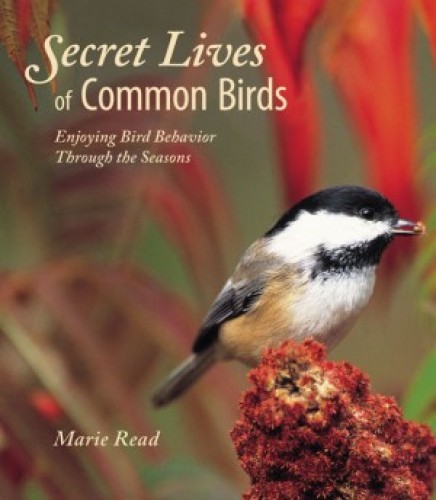by By Marie Read
Houghton Mifflin, 2005
As an ornithologist, many times I have witnessed an unusual bird behavior or been astonished by a bird’s beauty. And each time, I have muttered to myself, “if only I had a photograph of that.” Author and photographer Marie Read has captured those moments and more in her new book, Secret Lives of Common Birds: Enjoying Bird Behavior Through the Seasons.
With over 80 photographs, nearly every turn of the 95 pages made me exclaim to anyone within earshot, “Wow, you have to see this.” My favorite photo is of a black-capped chickadee sipping from an icicle. The image received a Nature’s Best Highly Honored award in 2002.
When I asked Read how she captured such a memorable image, she said, “I actually pre-focused on the icicle and waited for the chickadee to show up. The chickadees were coming in to a feeder that happened to be in the same tree where a branch had broken and the sap froze into an icicle. Every once in a while, a chickadee visiting the feeder would also sip from the icicle. I had my camera, telephoto lens, and flash ready, and I sat for many hours over several days to get the shot.”
It made me wonder just how many shots she had to take to capture that amazing image. “I might get 25 percent of shots that are keepers if they’re just portraits or if the bird isn’t moving much,” she said. “Far fewer – say 10 percent – if it’s action, and maybe only 1 percent to capture the perfect mix of peak action and perfect pose and illumination. Remember, though, that it’s not only the number of images you take, but the fact that you are there and aware enough to be ready for the action when it occurs!”
These are great photos, and they are accompanied by text that quickly gives the reader key information on bird behavior and natural history.
The book is organized by seasons, with each turn of the page presenting another interesting topic. Spring, Read’s favorite time of the year for bird behavior, has the most topics. She explains everything from bird song and wild turkey courtship to nest-building and mating.
Ever wonder how those long-legged great blue herons copulate? Although she doesn’t have a photograph of this private ritual, Read’s great description helps you conjure up your own image. How do birds drink? Most of them use the “dip and tip method,” as Read refers to the motion of the bird’s bill. But it surprised me to learn that doves and pigeons are among the few birds that can actually suck water up in their bills.
In my work, I get a lot of phone calls from curious birdwatchers. Read has great pictures and text explaining some of the most commonly observed situations: Why are cardinals constantly banging on my window? There is a bald-headed bird at my feeder – is it sick? I have a bird in my driveway with a broken wing but I can’t catch it. What should I do?
My only stylistic complaint is the overuse of exclamation points. Nearly half of the pages with text contain them! While it surely reflects her contagious passion and excitement, it can be distracting to the reader.
For me, the photographs outshine the text. I wanted to know so much more about the secret lives of these birds than Read divulged, and maybe that is one of the best things about the book. It will get you off your chair and out the door with a pair of binoculars and opened eyes.
And if you are inspired to carry a camera along, I asked Read what she would recommend to an aspiring bird photographer. She said, “Your backyard is the best place to start bird photography. Practice. Be there . . . again and again. Buy the best equipment you can afford; autofocus and image stabilization do make a difference. Use a tripod. It’s the best way to see a big improvement in the sharpness of you pictures . . . gosh I could write a whole book.” I think she should.


